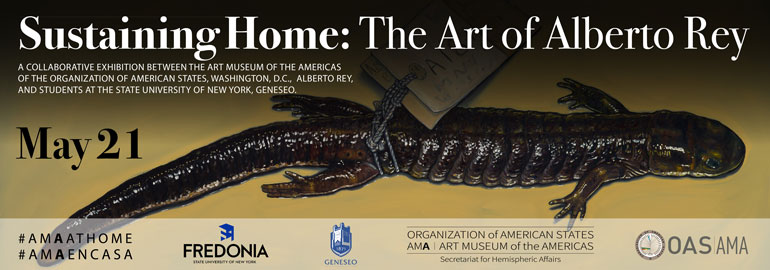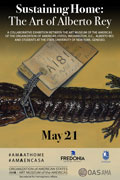
Theo Wright is a senior Art History major at Geneseo. While working on this project for Alberto Rey's work, he came to realize the power that art can have with not only creating a message, but its power to bring a community together. He feels that Rey's artwork has the capacity to spread the message of environmentalism while bringing people together so that they may have a better home for them and their children. He earned Honorary Mention for The Pam Eder Prize for Excellence, Annual Art History Department Symposium, SUNY Geneseo (2021).
May 31, 2021
Biological Regionalism: The Scajaquada Creek and the Ellicott Creek Projects and the Bagmati River Project
by
Theo Wright
Alberto Rey, is a Cuban American artist, who has had to make many homes throughout his life. As someone who has had to make new homes in very different environments, as many people have, Rey’s search for home is universally shared by anyone who has made significant moves and accompanying adjustments. Rey’s search for home manifests as his motivation for his series entitled Biological Regionalism, on which I have chosen to write for this exhibition. Alberto Rey's work entitled the Bagmati River project, which is part of this series, shows that he and those working alongside him, in Nepal, want to help procure fundamental human rights for the people of Nepal by supplying them with fresh water and air. Rey engaged within these projects to create something beautiful, but he also used his talent to take action as well as sending important messages about saving our planet. Since I am from Buffalo, I chose to include The Scajaquada Creek and The Ellicott Creek Projects in my study of Rey’s art to highlight Rey and his supporters' service to the community of Western New York State. These projects emphasize Rey’s commitment to the idea of protecting all of our homes on the Earth, wherever we may be and I approach my study of his work from a sustainability perspective because these activities are especially meaningful to me.
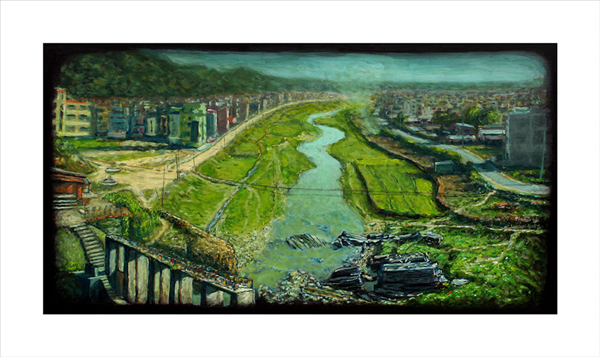
The Bagmati River Project: Bagmati River flowing into Kathmandu from Gokarna Gates, Kathmandu, Nepal, 2016, Oils on Plaster, 23 x 14”
The Bagmati River Project includes Alberto Rey's artwork and the actual work that went into the river clean-up. The Bagmati River is sacred to the people in the region of Kathmandu and Nepal. Rey worked within several UNESCO organizational networks and local communities, which participated in this project. As part of this project, Rey gained a residency at the Kathmandu Art Center with his colleague and graphic designer, Jason Dilworth, in 2016. Financial support for The Bagmati River Project was made possible from donors to his crowd-sourcing site and support during his sabbatical from SUNY Fredonia. The exhibition at the Siddhartha Art Gallery, at Babarmahal in Kathmandu, included Rey's artwork, Dilworth’s and Rey’s book on the project, student work from the Kathmandu University, and local water data. The project work included finding and identifying the source of the river’s pollution in understanding how climate change affected the pollution of the Kathmandu Valley. They also looked for ways to improve the river's condition. The pollution found in the river and its environmental impact on the region surrounding Kathmandu are found locally but they are a global crisis that must be addressed. By touring this exhibition, Alberto Rey wants to create connections between their region and the spectators’ region. Having people realize the importance of having an environmentally sound home can be learned from the Bagmati River's history and the grassroots efforts that created Saturday's Bagmati River Clean-up Program. In enacting this project, Alberto Rey and his supporters have connected the residents of the Kathmandu Valley to those of Buffalo, New York, who are engaged in similar projects, detailed below.
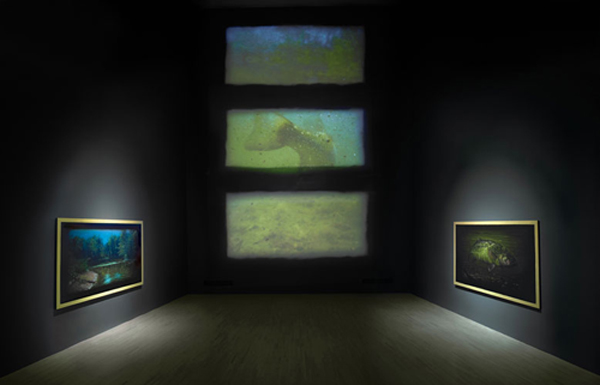
Installation Shot of Biological Regionalism: Ellicott Creek, Amherst, New York, USA, Lightwell Project Gallery, University of Buffalo Center for the Arts, Buffalo, New York, 2010
With three years of research and time in the studio, Rey produced The Scajaquada Creek Project, which caught my attention quickly as someone who has seen the effects of pollution on Buffalo's waterways. As a child and an adult, I have been to Delaware Park many times, seeing stuff in the water that I could not even describe, but I also remember seeing a part of the Creek that had been cleaned. I am very proud of Alberto Rey and the community around him for taking up this challenge of cleaning up this creek for Buffalo's animals and people. During this investigation of the creek, more than half-billion gallons of sewage flows into this creek every year. This sewage contains human feces that build to five feet in some areas of the stream. The sewage creates avian botulism that paralyzes and kills hundreds, if not thousands, of birds every year. To bring museum visitors to the experience of his observation, Rey, included in the exhibition, five 8-foot paintings of the Scajaquada Creek, water samples, data on the water quality, and a 70-foot map displaying the creek's course from the Buffalo River to Lancaster.
Another exhibition in the Biological Regionalism project is The Ellicott Creek Project at the University of Buffalo. Alberto Rey, in this exhibition, strove to connect the environment of the landscape and the wildlife of this creek. I am familiar with Ellicott Creek because I am from Buffalo and attended classes at UB's north campus, where this creek is located. This project aims to highlight the environmental crisis seen in our local waterways and form a stronger connection between the spectator and life around Buffalo. As he proceeded with this project, Rey analyzed different fish species found in bodies of water in the creek and around it. Rey uses video footage that documents the largemouth bass's underwater appearance during their annual migration to paint a realistic painting of the water quality seen in the creek. The videos record the iridescent nature of the water and document the environment above the water.
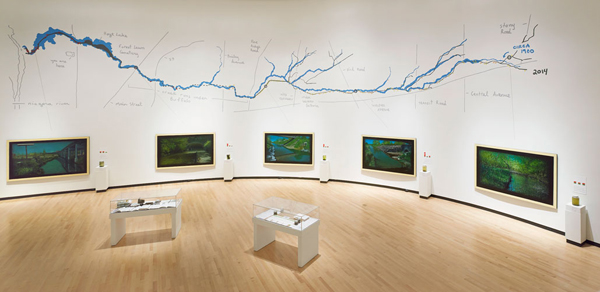
Installation shot of Biological Regionalism: Scajaquada Creek, Erie County, New York, USA, Burchfield Penney Art Center, Buffalo, NY
I was drawn to the Bagmati River Project and the entire Biological Regionalism project because Alberto Rey was working on The Scajaquada Creek Project, which sparked something in me, something nostalgic, that is part of my identity. Finding out about these projects that Alberto Rey and his supporters worked on in Buffalo reminded me of the pride I have for the city and the people of Buffalo while also realizing its shortcomings. It is also uplifting to see from within how the arts community has used their artistic talent to take action on the issues they want to reflect within their art. In his art, Alberto Rey shows these landscapes of bodies of water from Nepal and Buffalo in a way that makes the spectator admire and question the state of these environments. His artwork has allowed him to push forward, work with scientists, cultural organizations, and local communities to these places, and spread the message of environmentalism. Alberto Rey also brings in a central theme of protecting the animals affected by these polluted waters, which brings in the broader subject that every person and the animal should have accessible water that is not contaminated by our shortcomings. Seeing the Bagmati River Project compared to Buffalo's tasks shows that environmental issues are not a there and not here problem, but is a global issue. Bringing many of these works from Nepal and Buffalo, one can see that we must protect Earth, our home, wherever we may live.

